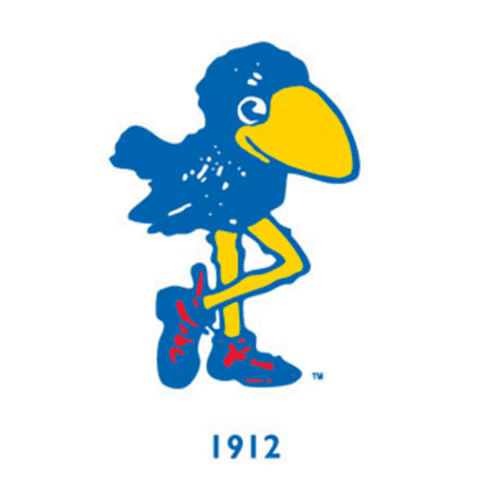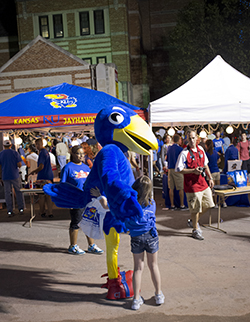Study finds nostalgia at the heart of sports retrobranding success

LAWRENCE — There’s a saying that everything old is new again. In sports, it seems everything old is cool again. Both professional and collegiate teams regularly roll out uniforms that are throwbacks to the team history, host celebrations of past glories and even paint their courts with old logos. While teams know it works to reach fans and sell them merchandise, what is not known is what consumers think of it and why it works. University of Kansas researchers have authored a pair of studies examining the sports retromarketing phenomenon.
 Nostalgia is a powerful factor in life, but the research found sports fans will dip into their pockets to be nostalgic for time periods when they weren’t even alive, and teams will market nostalgia that’s not even in their history. Brian Gordon, assistant professor of health, sport & exercise science, and Ollie Taniyev and Zach Scola, both KU doctoral students, authored the studies to better understand what form the marketing takes, what consumers think of it and what “retro” means.
Nostalgia is a powerful factor in life, but the research found sports fans will dip into their pockets to be nostalgic for time periods when they weren’t even alive, and teams will market nostalgia that’s not even in their history. Brian Gordon, assistant professor of health, sport & exercise science, and Ollie Taniyev and Zach Scola, both KU doctoral students, authored the studies to better understand what form the marketing takes, what consumers think of it and what “retro” means.
“There are plenty of examples of teams involved in retrobranding, but we don’t really know how consumers respond when their favorite teams do it,” Taniyev said. “This is an understudied area, and we wanted to know more about what makes marketing retro and what consumers think of it.”
The authors explored five practical areas of retromarketing in sport: imagery, merchandising, venue, game day promotions and advertising. Franchises who deal heavily in retromarketing often roll out imagery such as former logos and team colors and include them on everything from caps and jerseys to bobbleheads and souvenirs. But some teams such as the New York Yankees and colleges such as Penn State are famous for maintaining traditional uniforms that have changed very little over the decades. In those cases, venue is often used to prompt nostalgia, including team halls of fame that harken back to great players and team achievements, championship banners and retired jerseys hanging in the rafters, or even painting the court to include old logos, such as the Sacramento Kings have done recently.
To find out what consumers think of the practice, the researchers interviewed professionals working in sports marketing. They were asked about their organizations, their favorite teams, what they considered retromarketing and how they employed the practice. The study participants were quick to note nostalgia was one of the main things they thought of when it came to retromarketing. Visions of the past in their teams conjured memories of seeing games in their childhood, remembering why they first came to follow a team, watching with families, remembering great players of the past and specifically, the 1970s. Though a turbulent decade politically, the ’70s were cited repeatedly by respondents as an era they thought of when it came to retrobranding. Whether their team had great seasons in that decade or not, many said the design elements and colors brought that part of the past to mind.
But the association with the ’70s was not limited to memory or personal experience.
“We found out you didn’t even have to live it to feel nostalgic. Retromarketing still connected people to a time and place,” Scola said.
Respondents ranged in age from their 20s through their 50s, and nearly all cited thinking of the ’70s and their teams’ look at that time positively. And they were not alone in feeling wistful for a period when they didn’t exist; teams have done it as well. The Tampa Bay Rays, for one, have created “’70s throwback” uniforms, even though the franchise was founded in the 1990s.
As for what consumers considered to be retro, the respondents pointed to font and colors. Among the first things they thought of were the different styles of lettering team names and logos were presented in the past and the colors the marketing used, whether they were different from current team colors, slightly different or even the same.
Better understanding the phenomenon will not only reveal why and how it works but give marketers insight into what fans are nostalgic for and how to find new ways to keep them connected to the team. The researchers, who study athletic marketing consumer behavior — and also happen to be fans of retromarketing, Gordon noted — plan to study the topic further. It’s clearly working and making money, as some leagues such as the NBA have required teams to have an alternate fourth, or “throwback,” uniform, and nearly every team website has a retro merchandise page or offers items in a “classic look.”
“Right now, sporting organizations see the outcome is positive, but there’s not a deeper understanding of why it’s positive,” Scola said.
While some respondents reported buying “retro” gear even if they didn’t find it visually appealing, the researchers would better like to understand why fans keep coming back and shelling out their money and if there are types of retrobranding they would not approve of.
“On the retromarketing side, you’re paying a premium,” Gordon said. “These organizations clearly know what they have, as ‘retro’ merchandise is not cheap, but people still buy it.”
Sports seem to have a built-in advantage of their product offering a lived-in experience. People aren’t likely to be nostalgic for, or spend large amounts of money on obsolete technologies, to give one example, but harkening back to the teams of their childhood is a widely positive experience. Whether teams roll out retromarketing when they are losing or to celebrate past glories, it’s all over the field and uniform of many sports.
“I think sport is almost immune to backlash for this type of marketing,” Scola said. “Even when things are not well-taken, people stick with their teams.”
Photo: KU Marketing Communications.